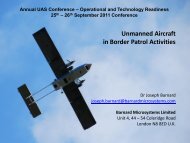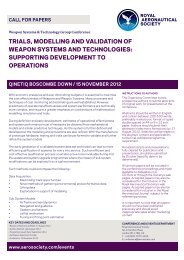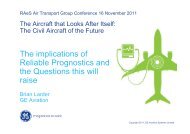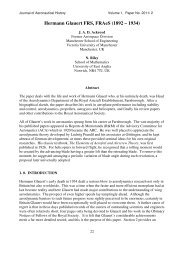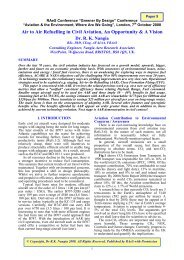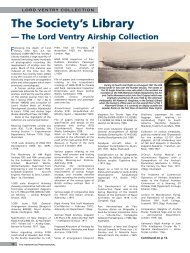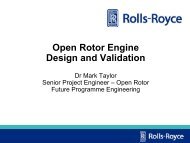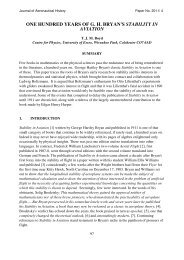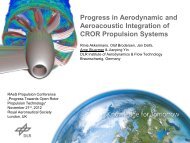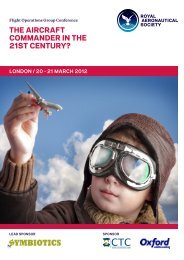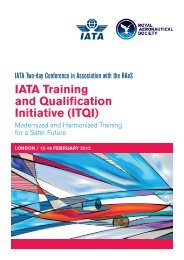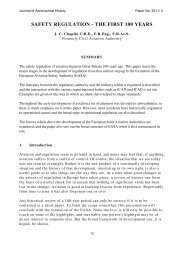DTS Paper.qxp - Royal Aeronautical Society
DTS Paper.qxp - Royal Aeronautical Society
DTS Paper.qxp - Royal Aeronautical Society
Create successful ePaper yourself
Turn your PDF publications into a flip-book with our unique Google optimized e-Paper software.
oader national science base will also figure in future planning.<br />
However, the <strong>DTS</strong>’s primary goal is to identify those areas of<br />
defence science and technology essential to maintain national<br />
sovereign capability, provide maximum leverage in strategic<br />
terms and provide the most overall technology benefit to the UK.<br />
In many sectors, the main focus is on through life management<br />
where the MoD will primarily invest in technologies designed to<br />
facilitate upgrading and long-term affordability. This includes<br />
commitment to developing open systems and systems<br />
architectures that will enable greater long-term flexibility and<br />
adaptability. In many cases the MoD intends to retain control over<br />
critical systems architectures.<br />
4.0 CROSS-CUTTING CAPABILITIES TECHNOLOGIES<br />
15. The MoD will seek to maximise returns from its investment,<br />
looking to derive multiple use from research. In this respect, the<br />
<strong>DTS</strong> puts considerable emphasis on cross-cutting technologies<br />
that will have the greatest impact across the range of defence<br />
equipment sectors. These are:<br />
■ Sensors and countermeasures<br />
■ Information exploitation<br />
■ Human factors<br />
■ Platforms and structures<br />
■ The physical environment<br />
■ Technologies to enable Through Life Capability Management<br />
(TLCM)<br />
Many of the individual technologies under this heading will be of<br />
relevance to aerospace — for example, simulation technologies<br />
have a priority in the human factors area. However, increased<br />
dependence on commercial sources, again noted in the<br />
simulation case, might place UK firms at a disadvantage if foreign<br />
competitors continue to receive funding through national<br />
defence and civil R&D budgets.<br />
16. C4ISTAR is also identified as a cross-cutting technology<br />
because of its role in most of the individual sectors and its<br />
centrality to delivering the MoD’s Network Enabling Capability<br />
(NEC). This is by definition a complex system of systems in which<br />
the aerospace element strictly defined is limited to the provision<br />
of aircraft and satellite platforms. There is no need automatically<br />
to buy these from a UK supplier unless there is a specific<br />
technological value in integrating platform with equipment and<br />
sub systems. The DIS, for example, recognises this in relation to<br />
micro satellites where the UK has a strong niche capability.<br />
17. Systems Engineering and Integration is rightly afforded<br />
prominence in the DIS. This capability is at the top of the defence<br />
industrial value chain. UK industry has a wide and deep set of<br />
capabilities across a wide-range of defence applications. On shore<br />
systems engineering and integration afford vital access points for<br />
high value UK-based equipment suppliers and will be essential in<br />
facilitating UK-based up grading and support. The DIS also reiterates<br />
the view that such skills are not monopolised by the<br />
traditional prime contractors but are possessed, perhaps more<br />
relevantly, by high-level equipment and IT companies. The key<br />
caveat must be whether the UK has sufficient systems engineers<br />
to meet these requirements. Nor is it clear from either the DIS or<br />
the <strong>DTS</strong> how the MoD intends to fund ‘systems integration’ R&D.<br />
By definition, such activity tends to be of a ‘one-off’ nature and<br />
thus a business case for industry investment is difficult to make.<br />
One approach used in the commercial world could be for the<br />
MoD and industry to work together to formulate the<br />
requirements for an MoD system to incorporate technologies for<br />
which an industry investment case could then be created.<br />
Procuring the Typhoon (above) and the JSF has removed the<br />
requirement “for the UK to design and build a future generation of<br />
manned fast jet aircraft for the foreseeable future.”<br />
5.0 AEROSPACE IN THE DIS AND <strong>DTS</strong><br />
18. For the aerospace sector (here defined as fixed wing, rotary<br />
wing, complex weapons, airborne mission systems, and some<br />
space elements), the DIS and <strong>DTS</strong> present some major challenges<br />
as well as some important opportunities. The continuing vital role<br />
of airpower, precision weapons and the C4ISTAR functions<br />
facilitated by air and space platforms are reiterated at length by<br />
the DIS and <strong>DTS</strong>. The UK also has substantial world-class design<br />
and development expertise in manned aircraft construction and<br />
systems integration, the development of guided weapons and in<br />
a wide range of mission systems. However, these statements are<br />
matched by a clear statement that the future will not be like the<br />
past and that the conventional view of airpower and its<br />
supporting domestic DTIB will be replaced by a different set of<br />
priorities, equipment needs and industrial infrastructure.<br />
Fixed Wing Aircraft<br />
19. The most telling aspects of the DIS and <strong>DTS</strong> are encompassed<br />
by two related assertions based on a view of contemporary trends<br />
in procurement, ever-increasing development costs, longer<br />
equipment life times and consequently fewer numbers that are<br />
eventually procured. This has been especially evident in fixed<br />
wing combat aircraft. Bluntly, procuring the Typhoon and the JSF<br />
has removed the requirement “for the UK to design and build a<br />
future generation of manned fast jet aircraft for the foreseeable<br />
future.” The main DTIB requirement henceforward will be to<br />
retain the technological base to upgrade and integrate new<br />
technologies. The provision of transport and other large aircraft<br />
platforms will be treated as a commodity to be acquired from<br />
international suppliers. Only specific UK operationally relevant<br />
technologies and through life management issues will require<br />
national technology investment.<br />
20. Moreover, in too many cases the flexibility and agility of<br />
airpower has not been “matched by agility in major aerospace<br />
programmes. The time and cost of relatively modest platform<br />
upgrades has too often been hard to justify and air power risks<br />
pricing itself out of business.” On the other hand, the<br />
development of Unmanned Airborne Systems is seen as a major<br />
opportunity to address the traditional economics of<br />
development, manufacture and employment of air systems. The<br />
<strong>DTS</strong> assigns a high priority to airborne sensors, defensive<br />
FEBRUARY 2007 7



